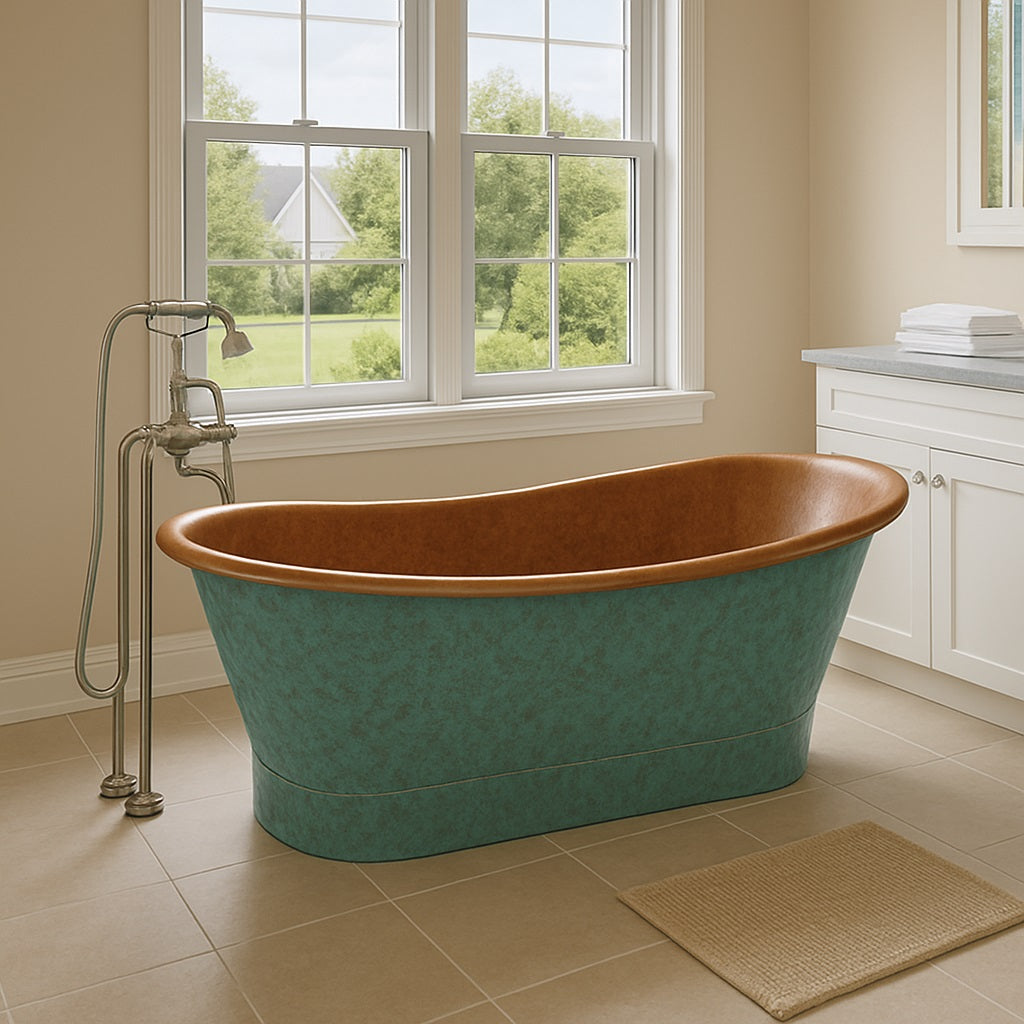
Are Copper Bathtubs Expensive? Unveiling the True Cost and Value
Share
At first glance, a copper bathtub can seem like a luxury splurge. However, beyond the warm glow and artisanal hammer marks lies a combination of craftsmanship, material value, and long-term performance that often justifies the initial price tag. In this comprehensive guide, we’ll explore:
- Key factors that influence copper tub pricing
- Aesthetic and functional benefits you won’t find in other materials
- Most popular sizes and how they impact cost
- Maintenance tips to preserve your investment
- Cost-versus-value comparison over the long haul
- Where to find and customize your perfect copper tub
What Makes Copper Bathtubs Priced the Way They Are?
Copper tubs aren’t mass-produced on an assembly line—they’re handcrafted by skilled artisans who shape, hammer, and finish each piece by hand. That labor-intensive process adds significant value:
- Artisanal Craftsmanship: Every tub reflects hours of hands-on hammering and shaping, creating subtle variations and textures unique to each piece. Learn more about the artisan process in this overview of copper bath benefits.
- Material Cost: Copper is a premium metal with its own market value, and the thicker the gauge used, the more you’ll invest. Many manufacturers source high-purity or recycled copper, which can also influence pricing.
- Customization Options: From slip-style silhouettes to deep oval forms, the more intricate the shape and larger the dimensions, the higher the cost. Popular models like the Grand Slipper Copper Tub can range significantly based on size and finish choices.
- Shipping & Installation: A filled copper tub can weigh upwards of 800–900 pounds (360–410 kg), requiring reinforced flooring and specialized freight handling. These additional logistics expenses factor into your final price.
Aesthetic & Functional Benefits That Add Lasting Value
While the upfront cost may be higher than fiberglass or acrylic tubs, copper offers distinct advantages that enhance both your bathing experience and your home’s resale appeal:
- Timeless Patina: Unlike static materials, copper develops a warm, evolving patina over time. This natural finish tells a story, imbuing your bathroom with character as documented in our maintenance guide.
- Antimicrobial Properties: Copper naturally inhibits the growth of bacteria and fungi, helping keep your bathtub hygienic without harsh chemical cleaners.
- Superior Heat Retention: Copper’s high thermal conductivity keeps bathwater warmer for longer, turning a routine soak into a spa-like immersion.
- One-of-a-Kind Beauty: No two hammered copper tubs are identical. The subtle dimples and textures reflect light in unique ways, making each tub a sculptural focal point in any bathroom.
Popular Copper Bathtub Sizes & Their Cost Implications
Size plays a pivotal role in pricing. According to the most popular size guide, these dimensions strike the best balance between comfort and cost:
- 48″ × 30″–33″ × 25″: Compact tubs ideal for powder rooms or guest baths—generally at the lower end of the price spectrum.
- 60″ × 30″–33″ × 25″: The classic “full-size” option for master baths—offers ample soaking space without breaking the bank.
- 72″ × 34″–36″ × 25″: Luxury spa-style tubs that command a premium for extra material and craftsmanship.
- 84″ × 36″–38″ × 25″ (Grand Slipper Style): Signature statement pieces like the Grand Slipper can double the material cost and labor, making them the most expensive—but also the most breathtaking.
Custom dimensions outside these standards can add 10–20% or more to the base price due to non-standard fabrication tooling and additional finish work.
Maintaining Your Copper Bathtub for Long-Term Value
Proper care ensures your copper tub remains a stunning centerpiece for decades. Follow these simple steps:
- Daily Rinse: Flush away soap scum and mineral deposits after each use to prevent buildup.
- Weekly Gentle Clean: Use a soft cloth with mild, pH-neutral soap—avoid abrasive pads or harsh chemicals.
- Spot Treatments: For water spots or light oxidation, apply a mixture of diluted vinegar or lemon juice, then rinse thoroughly.
- Periodic Waxing: Every 6–12 months, apply a thin layer of clear copper wax or mineral oil to seal and preserve the patina.
- Avoid: Bleach, ammonia, or steel wool, which can dull or scratch the surface.
Consistent care not only maintains shine but also protects against undue corrosion, maximizing your long-term return on investment.
Cost-Versus-Value: Is a Copper Tub Worth It?
Let’s break down the true investment:
- Initial Price Range: Entry-level copper tubs start around $4,000; mid-range models typically fall between $6,000–$8,000; high-end or oversized designs can exceed $10,000.
- Longevity: With proper maintenance, a copper bathtub can last 50+ years—far outliving acrylic or fiberglass alternatives.
- Resale Value: High-quality copper fixtures are increasingly sought after by luxury buyers, often adding to property appraisal values.
- Sustainability: Copper is 100% recyclable. Many brands, including My Custom Copper, incorporate recycled material in their production.
- Experience: The blend of warmth, antimicrobial benefits, and evolving patina deliver a bathing experience unmatched by conventional tubs.
Where to Buy and Customize Your Copper Bathtub
Ready to transform your bathroom with a handcrafted copper tub? Explore these resources:
- My Custom Copper Homepage – Browse their full range of baths, sinks, and accessories.
- Custom Copper Tubs Collection – Select your preferred style, size, and finish.
- Grand Slipper Copper Tub – Discover their signature slipper bath with generous proportions and deep soak.
Final Thoughts
Copper bathtubs undoubtedly carry a premium price tag, but their blend of artisanal craftsmanship, material quality, and enduring beauty offer a value proposition few other tubs can match. By understanding the factors that drive cost, exploring popular sizes, and committing to proper maintenance, you can enjoy a truly one-of-a-kind bathing experience that enhances both your home’s luxury and its market appeal. If you’re ready to invest in a masterpiece that evolves with time, head over to My Custom Copper and start customizing your dream copper tub today.
